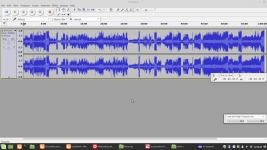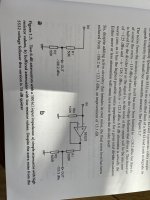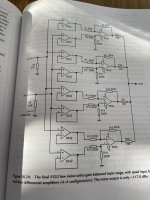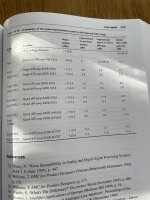The trouble here is what you determine as a passive circuit to which a 5532, is to compare, is largely borrowed from Mary Hallock Greenwalts 1919 rheostat patent. H01C10/04 Adjustable resistors with specified mathematical relationship between movement of resistor actuating means and value of resistance, other than direct proportional relationship https://patents.google.com/patent/US1357773A/en@Chris Daly adding active devices does not necessarily add noise. In Doug Self’s book on small signal circuits there is a section on “how to attenuate quietly”. In this he demonstrates that at typical signal levels and circuit impedances you will improve the signal to noise ratio by 15db by using op amps rather than passive circuits.
This is solid, repeatable and measurable. His sample used a 5532. There are quieter opamps than this now.
Passives of course have moved on , and no longer need to have restrictions which is what I described at [post #78 )
I think everyone is familiar with rheostats, or their smaller lower power cousins the potentiometer.
These devices use the laws of physics to provide their operation. The laws of physics also provide the noise output of these devices. My point was that by adding active devices it is simple to reduce the noise contribution whilst maintaining the same exact function.
Those patents don’t appear to address this.
Let me know if there was something in there I overlooked.
Your observation that passive devices have moved on is of course correct and we would not be in happy place we are today wrt to noise and distortion without modern metal film resistors.
These devices use the laws of physics to provide their operation. The laws of physics also provide the noise output of these devices. My point was that by adding active devices it is simple to reduce the noise contribution whilst maintaining the same exact function.
Those patents don’t appear to address this.
Let me know if there was something in there I overlooked.
Your observation that passive devices have moved on is of course correct and we would not be in happy place we are today wrt to noise and distortion without modern metal film resistors.
These devices use the laws of physics to provide their operation. The laws of physics also provide the noise output of these devices. My point was that by adding active devices it is simple to reduce the noise contribution whilst maintaining the same exact function.
Are you saying you seem to think, active devices are somehow by adding further active devices are lower in noise than a resistor ? 🙂
😗
Are you saying you seem to think, active devices are somehow by adding further active devices are lower in noise than a resistor ? 🙂
😗
No. That would indeed be funny 😄 You make the physics work FOR you rather than AGAINST you by using opamps in conjunction with MUCH lower resistance values. There is no magic here.
The weirdness you are perceiving wrt to additional opamps is that the internal noise of the devices is not correlated, therefore when you sum the outputs of multiple opamps, the noise signals partially cancel therefore doubling the number of opamps will drop the noise contribution by 3db for each doubling. This is a popular technique in circuits that require very low noise.
This is why I made my initial point about active devices not necessarily adding noise as this is a well known technique to minimize noise.
Note however that if the opamp input noise IS correlated, eg by bias current canceling circuits, then all bets are off and you won’t get the reduction you would otherwise expect. You need to choose appropriate opamps.
I hope that now makes sense. If not I’m afraid I may not have explained it well enough. 🙂
The weirdness you are perceiving wrt to additional opamps is that the internal noise of the devices is not correlated, therefore when you sum the outputs of multiple opamps, the noise signals partially cancel therefore doubling the number of opamps will drop the noise contribution by 3db for each doubling. This is a popular technique in circuits that require very low noise.
This is why I made my initial point about active devices not necessarily adding noise as this is a well known technique to minimize noise.
Note however that if the opamp input noise IS correlated, eg by bias current canceling circuits, then all bets are off and you won’t get the reduction you would otherwise expect. You need to choose appropriate opamps.
I hope that now makes sense. If not I’m afraid I may not have explained it well enough. 🙂
DACs nowadays output between 2 and 2.5V via RCA, and up to 5V or more via XLR.
So, in this digital world, preamps are often relegated to source selection.
So, in this digital world, preamps are often relegated to source selection.
I think you are expressing as a subjective opinion, and somehow not seeing the actual noise of active devices that irreversibly changes audio signal introducing non linearity, further influenced by power supplies and their noise contribution.
On the other hand and in comparison, a resistor is linear.
On the other hand and in comparison, a resistor is linear.
The media being played ( not the player ) restricts the output to 0.316V RMS , which is ample for a power amplifier with corresponding similar sensitivity.DACs nowadays output between 2 and 2.5V via RCA, and up to 5V or more via XLR.
So, in this digital world, preamps are often relegated to source selection.
This also applies to streaming where -14LUFS happens also to sensibly correspond with line level standards. Noting some DAC's can increase level further. The level increase risks distortion being added, You are right there is no need for active pre amplification with todays line level sources , rather the clever approach is matching input sensitivity at the power amp to be the same as consumer line level. As for switching and attenuation each should be done with contactless audio paths.At the same time achieving no adverse loading to the source impedance is outlined at Post #78
Attachments
Last edited:
Chris - I think you are confusing intuition with subjectivity. Intuitively it feels like adding active components must add noise right? I felt the same way to be honest. But once you follow the logic and the math it all starts to make sense.
You will find references to this technique in “The Art of Electronics” on page 495 where they use 5 transistors instead of one to reduce noise in a moving coil preamp.
The measured data and corresponding circuits are as shown below. From “Small signal audio design” by Douglas Self. If you have an interest in line level signal circuits and your participation here indicates that you probably do then I can strongly recommend this book.
You will find references to this technique in “The Art of Electronics” on page 495 where they use 5 transistors instead of one to reduce noise in a moving coil preamp.
The measured data and corresponding circuits are as shown below. From “Small signal audio design” by Douglas Self. If you have an interest in line level signal circuits and your participation here indicates that you probably do then I can strongly recommend this book.
Attachments
Many amps have far lower input noise power than a resistor already. Take the JFE150 JFET, input voltage noise 0.8nV/√Hz, input current noise 1.8fA/√Hz, both being about 100 times lower (40dB lower) than a 444k resistor (which has the same ratio of voltage to current noise). To have lower voltage noise than a JFE150 a resistor would need to be less than 38ohms, to have less current noise it would have to be more than 5 gigaohms... All ideal resistors at the same temperature have the same noise power spectral density.Are you saying you seem to think, active devices are somehow by adding further active devices are lower in noise than a resistor ? 🙂
😗
So active circuitry can be made to be far far quieter than the resistors, and allows resistor values in an attenuator to be much smaller (and thus have less voltage noise than the original passive atttenuator which is constrained by the source impedance.) The AD797 opamp's input FETs are similar in performance to the JFE150 if you want an opamp example.
Or you can use a passive attenuator in liquid helium...
The performance of the circuit as a whole is what counts, unless your source can directly drive the loudspeaker you have to go through active circuitry, and its performance is measurable in absolute terms - not sure what you mean by blurring, perhaps you could explain.i disagree, adding active circuitry just invites reactance and noise detracting and blurring from capability of the source.
Mark,The AD797 opamp's input FETs are similar in performance ......
there are no FETs in the AD797.
Indeed I goofed - the input devices of the AD797 are similar in voltage noise to that JFET, sub 1nV/√Hz
Well, to bring this back around, I have finally purchased a Noir kit from the store. I do plan to increase the gain a little bit for duty as a preamp only. I'm also going to need an input selector, but thats a passive device and easy enough.
This should work ok for my Aleph 30 amp.
Analysis paralysis has ended!
This should work ok for my Aleph 30 amp.
Analysis paralysis has ended!
I've wondered about building the Noir as a preamp as well . . . Please follow up with your thoughts.Well, to bring this back around, I have finally purchased a Noir kit from the store. I do plan to increase the gain a little bit for duty as a preamp only. I'm also going to need an input selector, but thats a passive device and easy enough.
This should work ok for my Aleph 30 amp.
Analysis paralysis has ended!
NSP, what is your PSU for the BA2018? I'm looking for the most straightforward and quiet PSU for a potential BA2018 build.I have a BA2018 and I am very pleased with this. Pairs very good with the F5 amplifier.
It wasn't too hard to build either.
I bought my psu from Gareth at audiosy.net, but it seems that the site is down. I am very pleased with this psu anyway.
I've wondered about building the Noir as a preamp as well . . . Please follow up with your thoughts.
Just ordered the entire BOM, got my pcb and case last week. Noticed the feet included in the project file on Mouser are now 1,000 moq. I should be able to find something at the hardware store. Hope to have this built by the new year!
if the only reason you needed a tone control was to tame your speakers a bit, you could consider just wiring a new crossover with a fixed resistor inline with the tweeter cap (the original XO seems as simple as can be, apart from the version that had a presumably variable treble pot anyway)
https://www.humanspeakers.com/e/epi100.htm
you could probably dial it in / compare a 1R, 2.2R, 3.3R wirewound from Parts Express or such. L-pad not really needed.
https://www.humanspeakers.com/e/epi100.htm
you could probably dial it in / compare a 1R, 2.2R, 3.3R wirewound from Parts Express or such. L-pad not really needed.
I have considered that. I did rebuild the speakers, new cap and surrounds, epoxied the magnets before they fall off, banana plug binding posts, but as it turns out, just yesterday a buddy messaged me asking if I had a sub, so now I will soon have a sub which I'm hoping will help with the highs. It wasn't much at all I needed to dial it back, not fatiguing or anything, just a little bright was all.
- Home
- Source & Line
- Analog Line Level
- So many amplifier builds, what about preamps?




